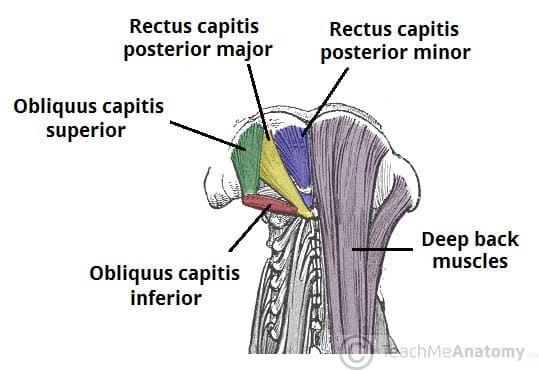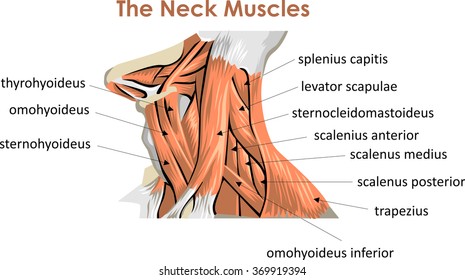Diagram Of Shoulder And Neck Muscles / Shoulder Injuries In The Throwing Athlete Orthoinfo Aaos - Myosin heads forms cross bridges with the actin 9.. The deltoid, teres major, teres minor, infraspinatus, supraspinatus (not shown) and subscapularis muscles (not shown) all extend from the scapula to the humerus and act on the shoulder joint. The trapezius, commonly referred to as the traps, are responsible for pulling your shoulders up, as in shrugging, and pulling your shoulders back during scapular retraction. Myosin heads forms cross bridges with the actin 9. Numerous muscles help stabilize the three joints of. The tropomyosin changes formation to reveal the active site on the actin 8.
The muscles of the neck run from the base of the skull to the upper back and work together to bend the head and. The trapezius muscle is located on the back of the upper. It is composed of three parts: Rowe shows how to fix muscle knots in your neck and shoulder in 30 seconds. When the rotator cuff is inflamed or irritated, this is referred to as rotator cuff tendonitis or shoulder bursitis.

The content of the neck is grouped into 4 neck spaces, called the compartments.
Working in pairs on the left and right sides of the body, these muscles. The movement of ions create a muscle action potential that travels down the t tubules of the sarcolemma 5. The trapezius, commonly referred to as the traps, are responsible for pulling your shoulders up, as in shrugging, and pulling your shoulders back during scapular retraction. Contains glands ( thyroid, parathyroid, and thymus ), the larynx, pharynx and trachea. In the front of the neck, the. When people talk about their neck muscles it is usually their traps that they are referring to. For that reason, and because of the dexterity of the shoulder joint itself, the musculature of the shoulder is complex, ranging from massive prime mover muscles to finer stabilizer and fixator muscles. The neck and shoulders are complex and interconnected areas, and medical problems that affect one often affect the other, as well. The tropomyosin changes formation to reveal the active site on the actin 8. Neck and shoulder muscles diagram the superficial back muscles attachments actions teachmeanatomy The deltoid, teres major, teres minor, infraspinatus, supraspinatus (not shown) and subscapularis muscles (not shown) all extend from the scapula to the humerus and act on the shoulder joint. Both the deltoid and the trapezius are firmly attached to the spine of the scapula. They move the head in every direction, pulling the skull and jaw towards the shoulders, spine, and scapula.
Bones in shoulder, ligaments of the shoulder joint, parts of the shoulder joint, shoulder anatomy, shoulder joints and muscles, shoulder structure anatomy, shoulder tendon anatomy, shoulder tendons ligaments, human muscles, bones in shoulder, ligaments of the shoulder joint, parts of. Learn vocabulary, terms, and more with flashcards, games, and other study tools. Although anchored in the neck, their primary functions are to move the shoulder blades and support the arms. Neck muscles are bodies of tissue that produce motion in the neck when stimulated. Working in pairs on the left and right sides of the body, these muscles.

Contains glands ( thyroid, parathyroid, and thymus ), the larynx, pharynx and trachea.
Muscles of the neck (musculi cervicales) the muscles of the neck are muscles that cover the area of the neck hese muscles are mainly responsible for the movement of the head in all directions they consist of 3 main groups of muscles: The muscles in the shoulder aid in a wide. Rowe shows how to fix muscle knots in your neck and shoulder in 30 seconds. The rotator cuff is a collection of muscles and tendons that surround the shoulder, giving it support and allowing a wide range of motion. The trapezius muscle is a large muscle bundle that extends from the back of your head and neck to your shoulder. Both the deltoid and the trapezius are firmly attached to the spine of the scapula. The trapezius, commonly referred to as the traps, are responsible for pulling your shoulders up, as in shrugging, and pulling your shoulders back during scapular retraction. In the front of the neck, the. Start studying superficial shoulder and neck muscles. Calcium binds to troponin on the actin 7. Labeled anatomy chart of neck and shoulder muscles on black background labeled human anatomy diagram of man's neck and shoulder muscles in an anterior view on a black background. These muscles form the outer shape of the shoulder and underarm. In order to reposition your neck to its optimal neutral alignment, we must first move it gently through a full range of motion.
Myosin heads forms cross bridges with the actin 9. The bursa is a small sac of fluid that cushions and. Muscles of the neck (musculi cervicales) the muscles of the neck are muscles that cover the area of the neck hese muscles are mainly responsible for the movement of the head in all directions they consist of 3 main groups of muscles: Contains glands ( thyroid, parathyroid, and thymus ), the larynx, pharynx and trachea. These critical parts of the upper body are very prone to developing pain because the position of all the bones in the neck and shoulders are completely dependent on the balance and alignment of the muscles and fascia that lash them together and allow for movement between them.

Although anchored in the neck, their primary functions are to move the shoulder blades and support the arms.
The upper arm bone, called the humerus, is connected to the body via the shoulder blade, which possesses the latin name scapula. Start studying muscles of neck, shoulder, and thorax figure 13.9 (part 1). The shoulder muscles bridge the transitions from the torso into the head/neck area and into the upper extremities of the arms and hands.for that reason, and because of the dexterity of the shoulder joint itself, the musculature of the shoulder is complex, ranging from massive prime mover muscles to finer stabilizer and fixator muscles. Learn vocabulary, terms, and more with flashcards, games, and other study tools. The shoulder is a complex combination of bones and joints where many muscles act to provide the widest range of motion of any part of the body. Pain and dysfunction from injuries or conditions that impact the joints, muscles, and other structures can easily spread from the neck to the shoulder(s) and from the shoulder(s) to the neck. The neck and shoulders are complex and interconnected areas, and medical problems that affect one often affect the other, as well. The shoulder has about eight muscles that attach to the scapula, humerus, and clavicle. These exercises are designed to open the chest and shoulder and reverse forward shoulder posture while gently strengthening the muscles that support the mid back. Neck and shoulder pain anatomy. Contains cervical vertebrae and postural muscles. Bones in shoulder, ligaments of the shoulder joint, parts of the shoulder joint, shoulder anatomy, shoulder joints and muscles, shoulder structure anatomy, shoulder tendon anatomy, shoulder tendons ligaments, human muscles, bones in shoulder, ligaments of the shoulder joint, parts of. For that reason, and because of the dexterity of the shoulder joint itself, the musculature of the shoulder is complex, ranging from massive prime mover muscles to finer stabilizer and fixator muscles.
Arm and shoulder bones the upper arm bone called the humerus is connected to the body via the shoulder blade which possesses the latin name scapula diagram of shoulder. There are both right and left traps, and they are used to support your arms and shoulders.

0 Komentar